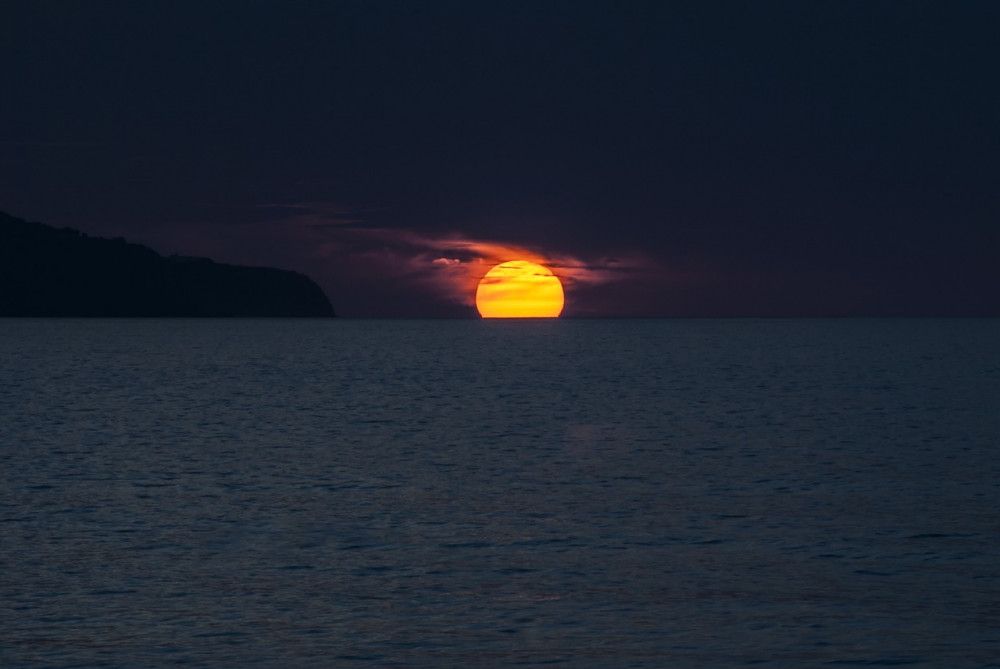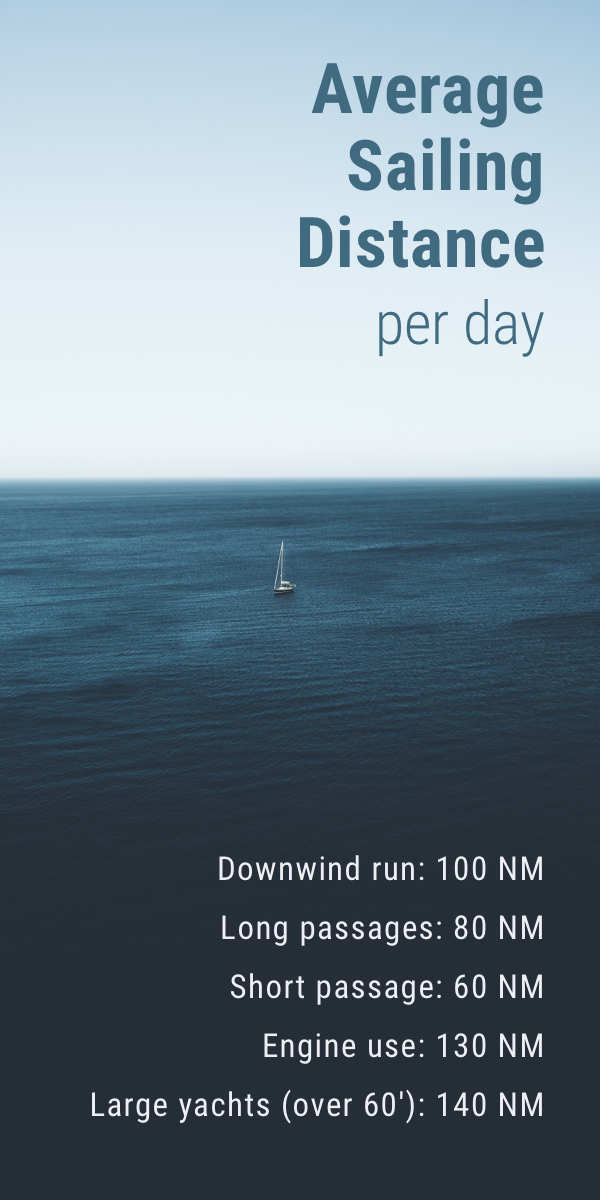How Far Can You Sail In One Day?
The average one-day sailing distance of a boat is important for planning passages. I've done the research and the same numbers kept coming up. Here they are.
How many nautical miles can you sail in a day? On average, sailboats can sail up to 100 NM (115 miles or 185 km) in one day when they run downwind. If the engine is used at all, this distance can increase to 130 NM on longer passages. With shorter passages, 60 NM is more typical. Large boats are faster than small boats.
Of course it depends on many factors, which I'll go into below. And if you want to learn how to calculate the average speed of your own sailboat, I have a neat sailors-trick for you below.

Average Sailing Distance in Different Conditions
Let's take a look at a couple of different conditions, and how it affects your sailing distance per day. These are rough numbers, but it gives you a general sense of what to expect.
- Downwind run: 100 NM
- Long passages: 80 NM
- Short passage: 60 NM
- Engine use: 130 NM
- Large yachts (over 60') in good conditions: 140 NM
1 NM is roughly 1.15 miles or 1.85 km.
Passages of multiple days allow you to sail non-stop, which increases the average distance per day. Shorter passages tend to result in lower averages. If the engine is used, sailors could increase their sailing distance by 20-40%. Larger yachts are able to cover up to 50% more distance per day, thanks to their length (more on that later).
The average small sailboat (under 32') cruises at roughly 5 knots. A knot is the number of nautical miles per hour, so it's difficult to calculate the distance. 5 knots = 5 nautical miles per hour.
- if you sail for 24 hours, that means you cover roughly 120 NM
- if you use the tides and sail for 8 hours, you cover roughly 40 NM (plus extra thanks to the tidal advantage)
The average mid-sized sailboat (32' - 48') cruises at roughly 6 knots.
- if you sail for 24 hours, you cover on average 144 knots
- if you sail for 8 hours, you cover roughly 50 NM
The average large yachts (over 50') cruises at about 7.5 knots.
- if you sail for 24 hours, you cover on average 180 NM
- if you sail for 8 hours, you cover roughly 60 NM
These are pretty optimistic estimates for optimal conditions, so let's take a look at all the things that can affect speed (both in a good and bad way).
Factors That Affect the Average Sailing Distance
Your average sailing distance depends on your speed. The most important factors that affect the speed (and so the average sailing distance) of your vessel are:
- hull length of the boat
- hull type
- wind conditions
- tidal conditions
- use of the engine or not
- sail surface - use of spinnakers or reachers
- conditions of your gear
- sailing times
Hull length of the boat - the length of your boat is directly related to her cruising speed. A good rule of thumb is: the longer the boat, the faster she goes. I'll explain how to calculate the speed below. On average, the following hull lengths cruise at roughly the following speeds:
- 24' - 5 knots
- 32' - 5.5 knots
- 40' - 6.5 knots
- 48' - 7 knots
- 54' - 7.5 knots
Hull type - multihulls are considerably faster than monohulls because they displace a lot less water. With high speeds, they lift out of the water and start planing. They're also more buoyant than monohulls. This allows for much higher speeds.
Wind conditions - Of course, an upwind tack will be much slower than a downwind run. Picking the right course is very important for a good average sailing distance.
Tidal conditions - You can get a tidal advantage by sailing with the tide under you. The tide can carry you and increase your speed.
Engine use - If you use the engine every time you find yourself in light air, it's a lot easier to get a 5+ knot speed average. Using the engine increases the average sailing distance a lot. But in my opinion that's not really part of the sailing distance, it's part of the motoring distance.
Sail surface - If you have a large sail surface, for example by using your spinnaker a lot, you gain some speed, which increases the sailing distance. The downwind trade wind run from east to west crossing the Atlantic is a famous route. You can reach distances of well over 120 NM a day there.
Gear condition - Believe it or not, the condition of your gear does affect the sailing speed. In fact, old, worn sails can reduce your cruising speed with 1 knot on average, maybe more. That's crazy. So if you're planning a long distance passage, be sure your sails are in good order. Same goes for the hull. If it's clean and smooth, it will create less friction, allowing it to go faster.
Sailing times - Sailboats can travel 24/7 on open seas, so they can cover a lot more miles than most people think. Alright, they aren't super fast, but they can eat miles around the clock.
So those are the main factors that affect speed and sailing distance. Let's have a look at how to take an educated guess for your passage.
How To Calculate the Average Sailing Distance
There are a couple of good ways to estimate the average sailing distance for your trip.
An old sailor's trick is to take the square root of the waterline (LWL) in feet. This actually gives you a surprising solid estimate for your boat.
If you really want to get into the math, I've previously written an article on calculating the maximum hull speed of a sailboat, that's really worth checking out.
Spoiler: if you want to calculate the maximum hull speed, the formula adds 34% to the square root of the LWL. That gives you an estimated maximum hull speed.
Another way is to keep a captain's log of your travel and calculate a real-world average for your boat and sailing skills. Simply divide your distance by sailing time. This gives you the average speed (in knots) or distance (in NM).
I also recommend asking sailors with experience on that particular passage what their average sailing distance was. They know things I don't. Each passage is different and has specific conditions that you only get to know by actually going there. They are the best source out there.
What To Do With This Knowledge
In planning your trips, you should be very conservative. It's best practice to take the most conservative numbers. I like to take about 25% off the average theoretical speed. So if my average speed was 6, it's now 4.5 knots.
There will be days when there's no wind whatsoever, or I have to deal with wind shifts or something. Or something breaks. You never know, but something you didn't plan on will probably happen.
Also, go easy on your distance estimate. You never sail in a straight line, so be sure to add another 30% simply to account for drifting off course, making a navigational error, and so on.
Plan your provisions accordingly. It's not a plane flight with a hotel and restaurant on either side. It's you and canned foods. And when you run out it's you and potentially unlimited fish - if you can catch them.
Related Questions
Does the length of a boat affect its speed? The speed of a boat is directly related to its hull length. The longer the boat, the faster its average cruising speed will be. A longer hull has to displace relatively less water per foot, which results in a higher maximum hull speed. Calculate the average speed by taking the square root of the length at waterline.

Did you find the answer to your specific question?
👍 44 👎 3
Leave a comment